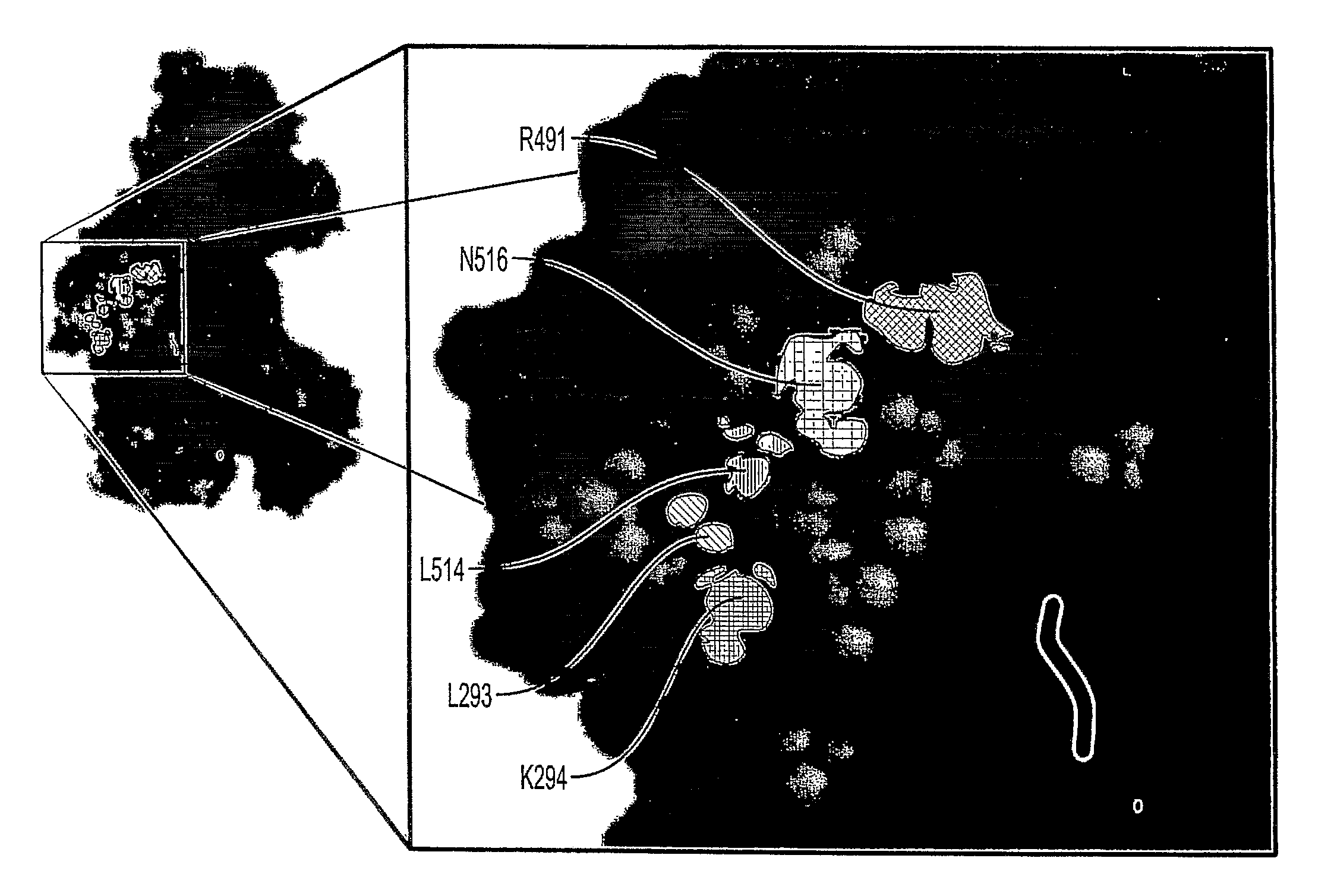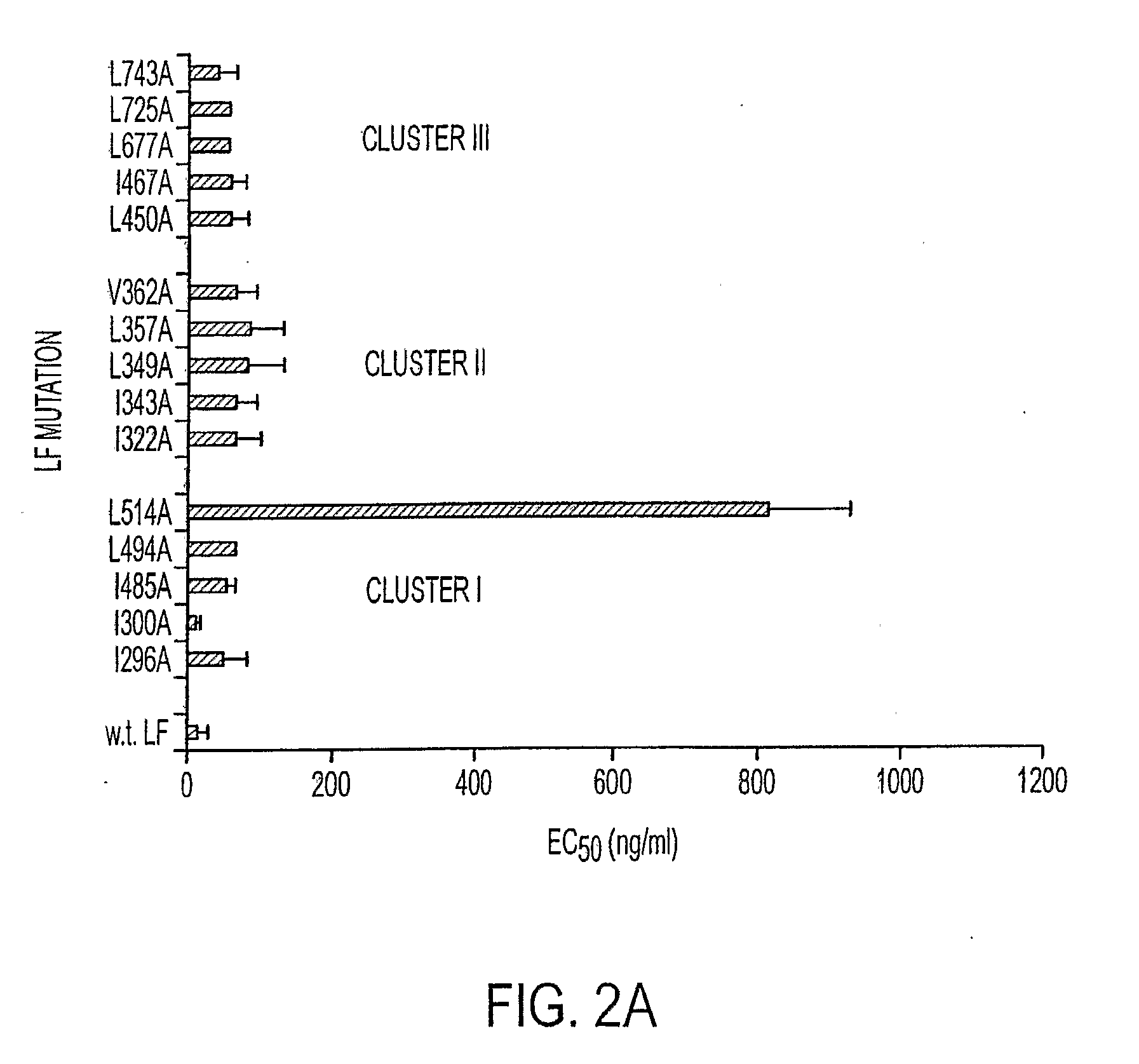Domain II Mutants Of Anthrax Lethal Factor
a technology of anthrax and mutants, applied in the field of anthrax lethal factor mutants, can solve problems such as hypotension shock leading to death
- Summary
- Abstract
- Description
- Claims
- Application Information
AI Technical Summary
Benefits of technology
Problems solved by technology
Method used
Image
Examples
example i
Methods and Materials
Cell Lines, Culture and Reagents
[0072]The murine macrophage-derived J774A.1 and the Chinese hamster ovarian epithelial (CHO)-K1 cell lines were obtained from the ATCC (Manassas, Va.). J774A.1 cells were cultured in Dulbecco's Modified Eagle Medium (DMEM) supplemented with 10% fetal bovine serum (FBS), 1% penicillin / streptomycin. CHO-K1 were cultured in Ham's F-12 medium supplemented with 10% FBS, and 1% penicillin / streptomycin. Both cell-lines were maintained at 37° C. in a humidified 5% CO2 incubator.
Site-Directed Mutagenesis
[0073]Alanine-substitutions in LF were generated by introducing mutations into a B. anthracis LF expression vector pSJ115 (Park et al., supra) with the use of the Quickchange™ site-directed mutagenesis kit (Stratagene, La Jolla, Calif.) following manufacturer's instructions except that primer extension was allowed to continue for 18 min and the deoxynucleotide triphosphate (dNTP) stocks were modified to reflect the high deoxyadenylate and d...
example ii
Site-Directed Mutagenesis of Clustered Aliphatic Residues
[0086]Since a number of the conserved residues in the LFIR are long-chain aliphatic residues, the present inventors conceived that a complementary region on LF would contain clustered aliphatic residues and would lie close to the groove into which the NH2-terminus of MEK fits. A surface plot of LF shows three distinct clusters of aliphatic residues meeting this requirement (FIG. 1). The first is composed of aliphatic residues (I298, I300, I485, L494, and L514) present in domain II and lies at one end of the catalytic groove. The second (residues I322, I343, L349, L357, and V362) is composed of elements of the second, third, and fourth imperfect repeats in domain III and lies at the opposite end of the catalytic groove. A third cluster present in domain IV (L450, I467, L677, L725, and L743) lies adjacent to the catalytic groove which receives the NH2-terminus of MEK.
[0087]To test this, site-directed mutagenesis was employed to ...
example iii
Point Mutations in Domain II Do Not Reduce LF's Affinity for PA or its Ability to Translocate Across the Plasma Membrane
[0089]LF is a Zn2+-metalloprotease which specifically cleaves the NH2-termini of mitogen-activated protein kinase kinases. To determine whether clustered residues in domain II are required for LF proteolytic activity we assayed MEK2 cleavage by immunoblotting in J774A.1 macrophages which had been treated for 2 h with PA (0.1 μg / ml) plus wild-type LF or LF containing alanine mutations (0.01 μg / ml) in this region. Of the proteins tested, only wild-type LF and LF containing alanine mutations which had a neutral or marginal effect on toxicity were able to cleave the NH2-terminus of MEK2 (FIG. 3a). By contrast, L293A, K294A, R491A, L514A, and N516A as well as the double mutants L293A / L514A, K294A / L514A, R491A / L514A, and L514A / N516A caused no or reduced MEK2 cleavage. These results are consistent with our observation that only these residues of domain II play a key role ...
PUM
| Property | Measurement | Unit |
|---|---|---|
| Immunogenicity | aaaaa | aaaaa |
| Toxicity | aaaaa | aaaaa |
Abstract
Description
Claims
Application Information
 Login to View More
Login to View More - R&D
- Intellectual Property
- Life Sciences
- Materials
- Tech Scout
- Unparalleled Data Quality
- Higher Quality Content
- 60% Fewer Hallucinations
Browse by: Latest US Patents, China's latest patents, Technical Efficacy Thesaurus, Application Domain, Technology Topic, Popular Technical Reports.
© 2025 PatSnap. All rights reserved.Legal|Privacy policy|Modern Slavery Act Transparency Statement|Sitemap|About US| Contact US: help@patsnap.com



